Oklahoma is home to a variety of turtle species, and it is very rich in turtle diversity. These turtles can be spotted in many habitats, including lakes, bogs, rivers, marshes, ponds, and marshes.
How many turtle species are there in Oklahoma?
Oklahoma is home to about 17 native turtle species. They are:
- Three-toed Box turtle
- Alligator Snapping
- Razor-backed Musk
- Yellow Mud Turtle
- Common Map
- Ouachita Map Turtle
- Mississippi Map
- Mississippi Mud
- Ornate Box Turtle
- Eastern River Cooter
- Western Chicken Turtle
- Common Snapping Turtle
- Red-eared Slider
- Common Musk
- Painted Turtles
- Spiny Softshell
- Midland Smooth Softshell
Turtles in Oklahoma and the US are categorized as Special Concern, threatened species, not at Risk, and Endangered. We will have a look at the category each of these turtles in Oklahoma belongs to.
Further, we will dig deep into their features and characteristics that would help you to distinguish them.
1. Three-toed Box Turtle
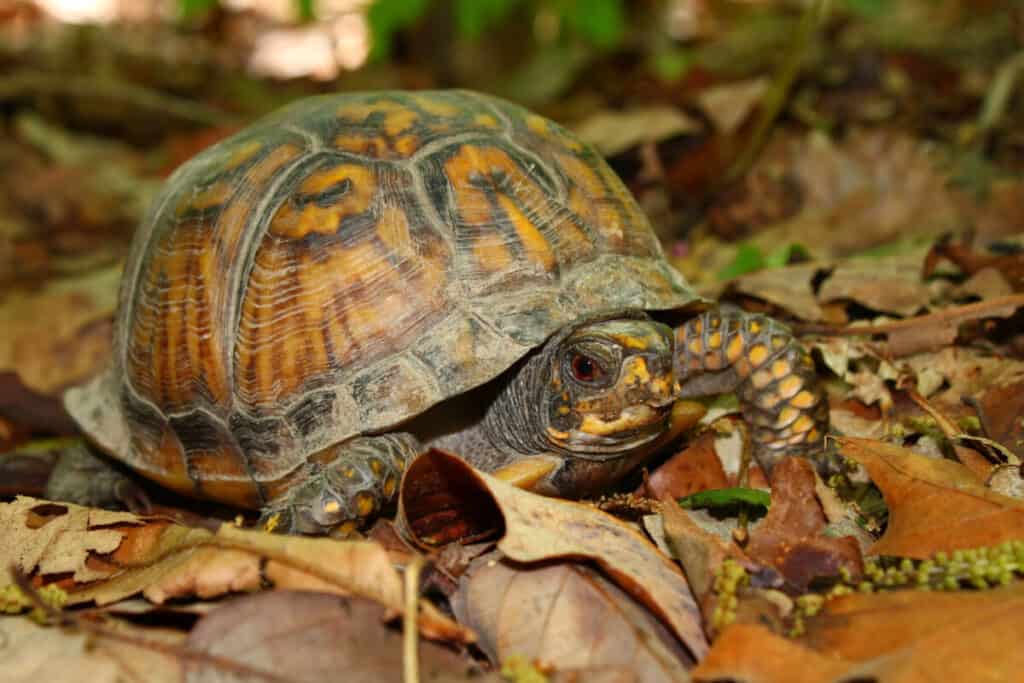
This is one of the two box turtle species found in Oklahoma, and they are a subspecies of the Eastern box turtles. Three-toed box turtle bears the scientific name Terrapene carolina and is common in the Eastern area of this state. It gets its name from the three toes it has on its hind limb instead of four.
The carapace (upper part of the shell) and plastron (lower part of the shell) are plain brown in color, although the carapace sometimes has yellow markings or stripes. Its plastron is hinged at the anterior and posterior areas and is also shorter than the carapace.
Male three-toed box turtles can be distinguished by the red markings on their front limbs and red eyes. On the other hand, females bear brown scales and brown eyes.
Three-toed box turtles mainly inhabit grassland and woodlands areas. They are primarily terrestrial and often walk around looking for food. These turtles are commonly seen along paved highways in the evenings and early in the morning.
Because they are omnivores, they mainly feed on insects, mollusks, fish, and also plants.
When mature, three-toed box turtles reach a length of 6.5 inches. Males are often smaller than females. They attain sexual maturity at between 4 and 5 years. On the other hand, hatchling three-toed box turtles measure about 1.5 inches.
Their lifespan can be as long as 70 years. If you wonder how to tell how old a three-toed box turtle is, count the number of rings and divide this by two. The answer is a rough estimate of its age.
In terms of reproduction, these turtles lay eggs on land as with all other species. They mate during spring and have the ability to store viable sperms for some years. As such, they don’t need to mate yearly for the females to lay eggs. It lays eggs in clutches that carry one to seven eggs. This species can lay an impressive six clutches in a single year.
2. Alligator Snapping Turtle
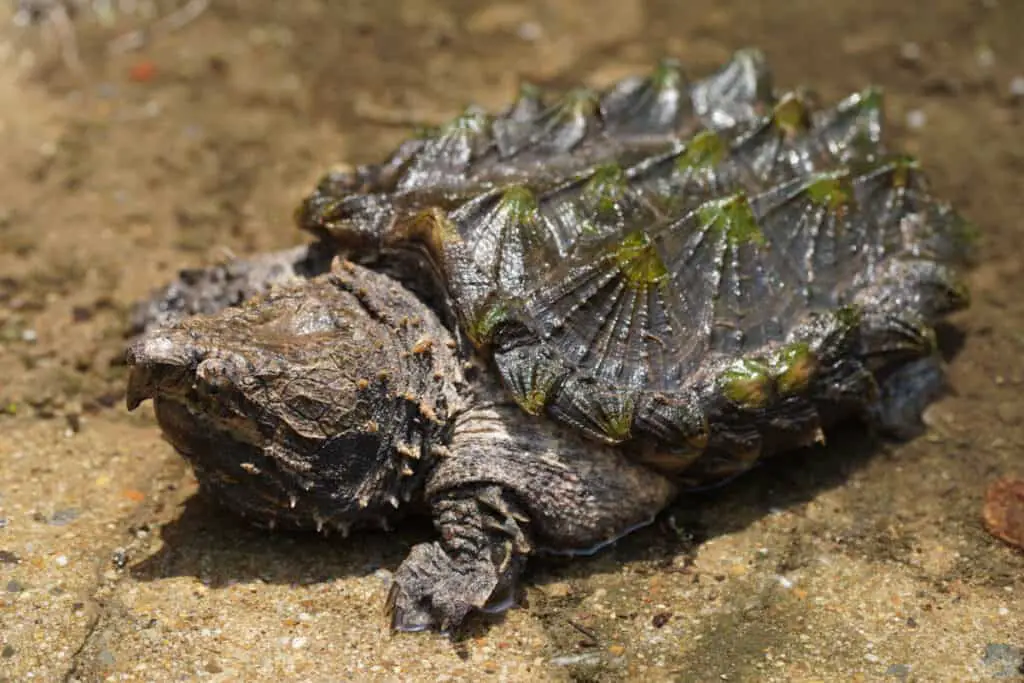
This turtle species gets the name from the sharp beak they have used to catch prey. Scientifically, alligator snapping turtles are known as Macrochelys temminckii. Alligator snapping’s skin has spike-like features. The spikes are also visible on the carapace, although they are not sharp.
Alligator snapping turtles feed on an omnivorous diet, and although they are not very active, they hunt for their prey by staying still at the bottom of water bodies with the mouth open, ready to snap their prey.
They are aquatic and inhabit the bottom of rivers, swamps, bayous, sloughs, and lakes. Alligator snapping turtles have a lifespan of 60 – 70 years.
If you consider getting this turtle as a pet, you need to know that it can grow significantly big. They can grow to 15 – 26 inches, and the biggest known was 31.5 inches making them one of the giant turtle species worldwide.
Alligator snapping turtles are some of the endangered turtle species in Oklahoma. As a result, various conservation groups and agencies have been working on breeding snapping turtles and releasing them into the four major rivers in Oklahoma.
Nesting starts in May and ends in July, after which incubation takes 70 – 100 days, depending on the hatching temperatures, moisture content, and other vital factors.
Alligator snapping turtles are considered to be species of special concern in Oklahoma because of their low reproduction rate.
3. Razor-backed Musk Turtle
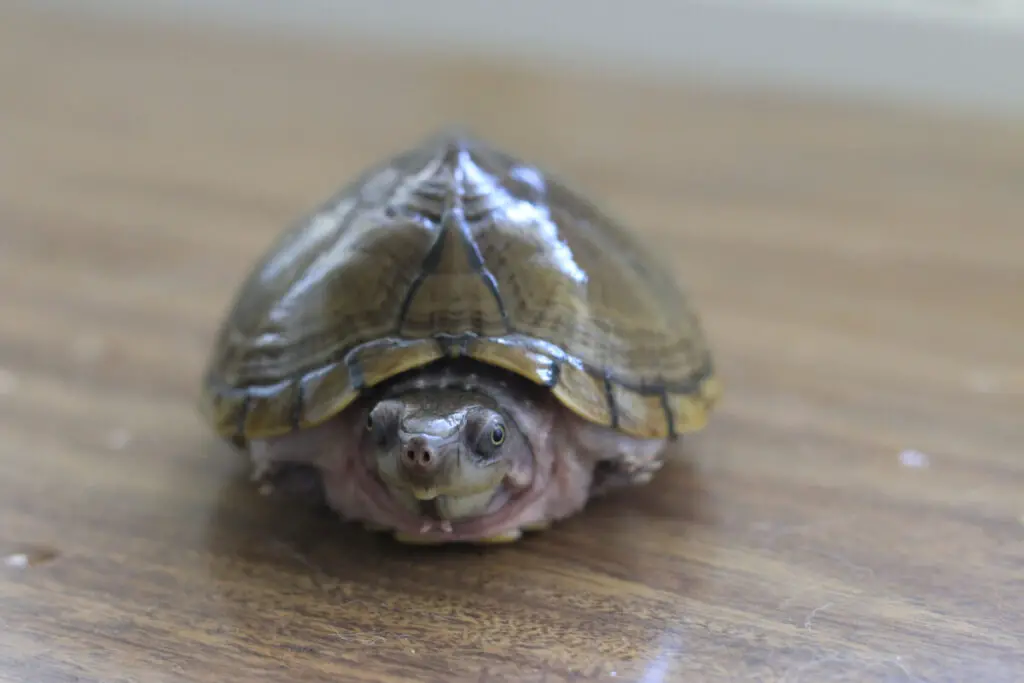
Biologically, this turtle species is known as Sternotherus carinatus. They are also referred to as keeled musk turtles. Razor-backed musk turtles are some of the most secretive turtle species. The species hardly grow big as they measure 5-6 inches in carapace length when mature. Their hatchlings measure 0.9 – 1.1 inches.
Razor-backed musk turtles’ shell color ranges between olive, brown and black and have black lines all through. Their shell scutes resemble razor humps which is where they get their name from. The scutes are edged in black, and their skin is brown or grey and has black spots.
They feed on a carnivorous diet, mainly eating mollusks, small fish, crustaceans, and insects.
This turtle species native to Oklahoma is aquatic. Razor-backed turtles mainly inhabit slow-moving water bodies such as ponds. They often hide in aquatic vegetation and spend time basking on land. They also have a great preference for areas with logs for basking.
In terms of reproduction, they reach sexual maturity at either the ages of 4-8 years or when they attain a carapace length of 3 – 4.5 inches. Females lay up to 3 clutches in a year, with each clutch carrying up to 7 eggs.
If you are looking for an easy-to-handle turtle species, the razor-backed species is a great choice. They cost between $60 and $ 150.
Razorback turtles are species of least concern in Oklahoma.
4. Yellow Mud Turtle
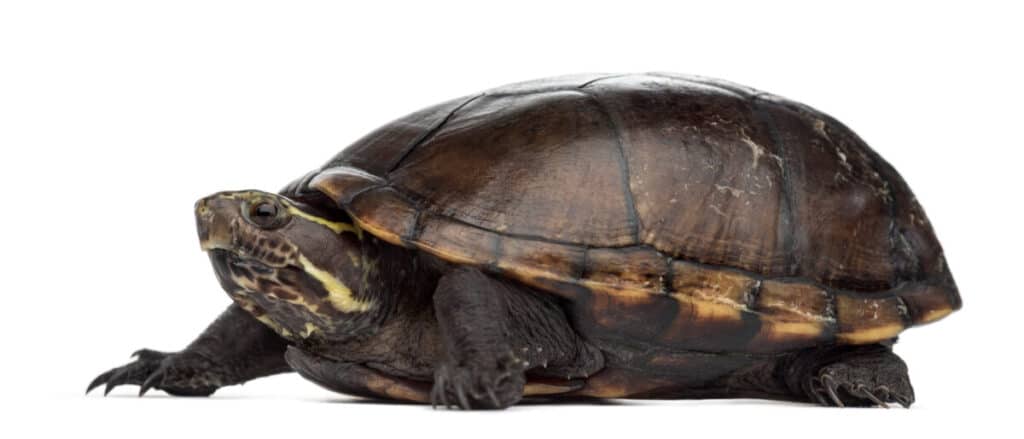
Scientifically known as Kinosternon flavescens, these turtles have a smooth, flattened but wide upper shell. The midline is slightly depressed due to the lack of a vertebral keel. Its carapace ranges from olive to brown and yellow, while the plastron is often brown or yellow and is hinged at the front and back.
Their long necks are yellow, and the males at times have gray specks on them. The four limbs are pretty strong, with webbed feet and long claws.
A distinct character of the yellow mud is that they have a terminal horny spur. Although present in both males and females, it is less visible in females. Males also have bigger, thicker, and more spine-tipped tails, while the concavities of their lower shells are more pronounced, and their hind limbs bear rough scales patches.
These turtles are omnivorous, primarily feeding on mollusks, earthworms, actions, crustaceans, fish, and aquatic plants. They hardly hunt for prey as they are opportunistic feeders. In addition, they often feed while in the water; only on rare occasions do they feed on land.
Adult yellow mud turtle males measure up to 6 inches while females are smaller, only measuring 4 to 5 inches. They might live up to 40 years.
Yellow mud turtles are aquatic though they also spend plenty of time on land. This turtle species inhabits ponds, rivers, ditches with water, sloughs, and Oxbow lakes. During freezing and scorching temperatures, they hide in mud.
They mate between April and May but also in September. Nesting occurs in either June or July, and they lay between 6 and 8 eggs. This species is known to make multiple nests to increase the chance of their eggs surviving predators.
5. Common Map Turtle
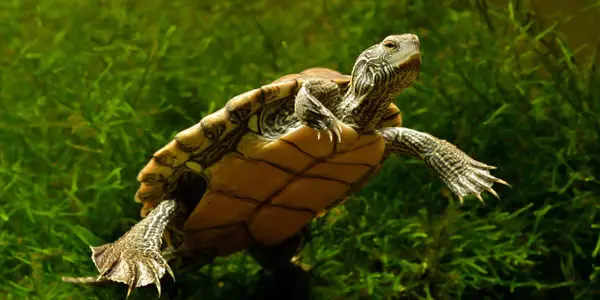
Scientifically, this turtle species is known as Graptemys geographica. These turtles are some of the most widely spread turtles in Oklahoma. Northern map turtle is another term used to refer to this species.
Their appearance is marked by olive green to dark brown shells. These shells look like contour lines on a map. The small yellow spots behind each eye are what make them unique from the other map turtles.
Common map turtles are mainly carnivorous, feeding on insects, small fish, and crustaceans. On rare occasions, they feed on plants.
In terms of habitat, they are aquatic, often inhabiting lakes, ponds, and rivers. Largely they prefer water bodies with basking spots such as debris or fallen trees. This species makes great swimmers and hardly moves far from water even when basking.
Common map turtles remain underwater during winter and go completely dormant, often together with other common map turtles.
When mature, an adult measures 3.5 inches to 10.5 inches. They often live for 20 years but can live for longer in captivity if well taken care of.
Mating occurs during fall and spring, and they often mate beneath the water. Nesting takes place between May and July, and common map turtles often prefer well-drained sandy soils. A clutch carries between 6 and 20 days, and they lay multiple clutches in a year. On average, their eggs take about 60 days before hatching. As such, hatchlings start emerging in August.
Common map turtles are easy to keep, even for people with no previous turtle experience. A juvenile will cost you between $20 and 60.
6. Ouachita Map Turtles
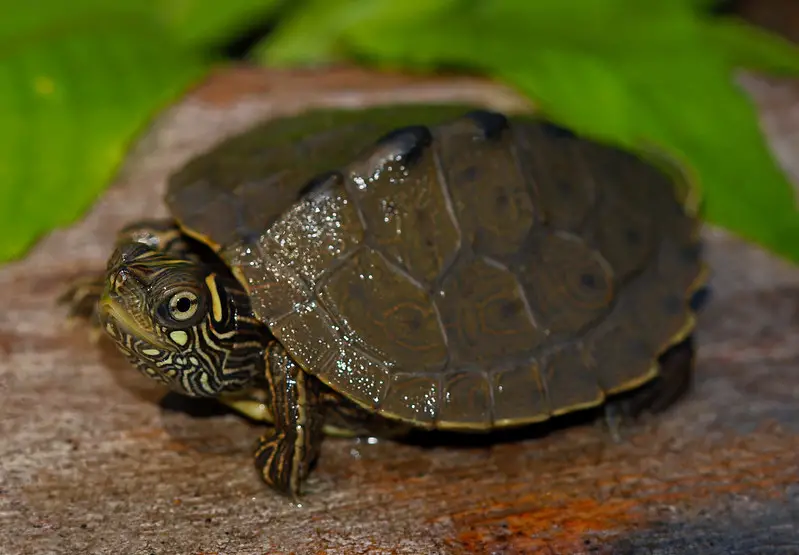
Biologically, this turtle species is known as Graptemys ouachitensis ouachitensis.
Their carapace is olive or brown in color. The back part of their carapace is strongly serrated. The plastron lacks markings and is lightly colored in plain yellow. Their hatchlings have saw-toothed knobs forming a row at the back’s center, which wears down as they age.
Its legs and head have brightly colored yellow circles and lines. Behind each eye, there is a broad yellow spot and big yellow or orange markings that extend while narrowing towards the top part of the head.
They are small to medium-sized, with males being smaller, measuring between 3.5 and 6.5 inches, while the females measure 5 – 10.5 inches.
This turtle species diet is largely omnivorous, with females being more herbivores while males are carnivorous. They feed on aquatic vegetation, insect larvae, dead fish, and very minimal amounts of snails.
Because they are Ouachita map turtles are aquatic, they mainly inhabit large creeks and rivers, while on less common occasions, they may be seen in sloughs and Oxbow lakes. It is rare to see them in ponds, lakes, and small streams.
Ouachita map turtles are good swimmers with a preference for water bodies having a moderate current. They also prefer bodies with basking spots such as floating logs and also hiding spots.
In terms of reproduction, they mate during spring, with females laying up to 25 eggs in a clutch. Hatchlings emerge towards the end of summer. Sexual maturity is reached at around 14 years.
7. Mississippi Map Turtle
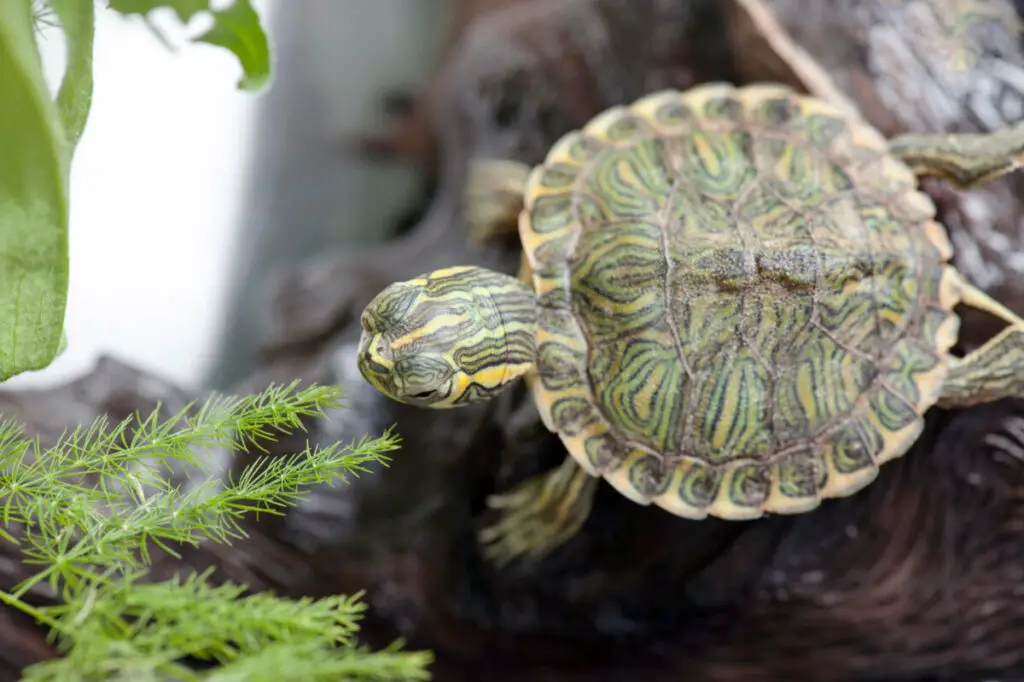
Yet another map turtle in Oklahoma is the Mississippi map turtle, also known as Graptemys pseudogeographica kohnii. They are a subspecies of False Map turtle and grow to medium size of 3.5 to 10.5 inches in carapace length. When fully grown, males are smaller than females.
Their carapace is black or dark brown and has yellow contour markings that seem like a map, hence the term map turtle. When mature, most of them have different keels with black tips that traverse the shells. The scutes of these map turtles are found of the shell’s rear end and are serrated.
They are aquatic and hardly wander far from their habitats. This turtle subspecies mainly inhabits the Mississippi River as well as its tributaries. In Oklahoma, they occupy large river streams, lakes, and rivers in the eastern part. At times, they can be seen basking, especially in summer.
Mississippi map turtles have a lifespan of between 40 and 50 years.
Although their diet is mainly herbivorous, their young ones feed on a rich protein diet for their growth needs. These protein-rich foods include frog spawns, fish, and aquatic insects. Baby turtles have to fend for themselves as all turtles do not nurture their young ones.
Females look for breeding spots near the water bodies but far from the reach of rising water levels. Mississippi map turtles lay between 5 – 20 eggs which take about 50 to 70 days to hatch.
8. Mississippi Mud Turtle

Scientifically this species is known as Kinosternon subrubrum hippocrepis. It is a subspecies of the Eastern Mud turtle and is often dark and small, only measuring between 3 and 5 inches when mature.
When mature, it measures about 8 inches. A distinct feature is that males have a tail that resembles a claw. For both sexes, the hind limbs are webbed while the front is not.
Mississippi map turtle’s carapace is either black or dark brown and has no spots or markings. Its plastron is black with some brown marks and is bigger than in other turtle species. The plastron is hinged at the anterior and posterior, though not closable. The sides of the neck either have dull tan stripes or yellow-colored ones running downward.
These semi-aquatic turtles prefer moist habitats. As such, they are common in slow-moving, shallow, or stagnant water with aquatic vegetation such as bayous, ditches, lakes, swamps, and ponds. They hardly bask.
When young, these mud turtles make poor swimmers, so pet owners need to keep water levels in the tank low. In Oklahoma, they are common on the Eastern side. They have a lifespan of 25-50 years.
Mississippi mud turtles’ diet is omnivorous, and they mainly feed on aquatic insects, snails, and vegetation.
Mississippi mud turtles’ main predators in captivity are hunters who capture mature ones. They also face the threat of pesticide poisoning while some die when crossing the road.
If you are thinking of getting this turtle as a pet, it will cost you about
9. Ornate Box Turtle
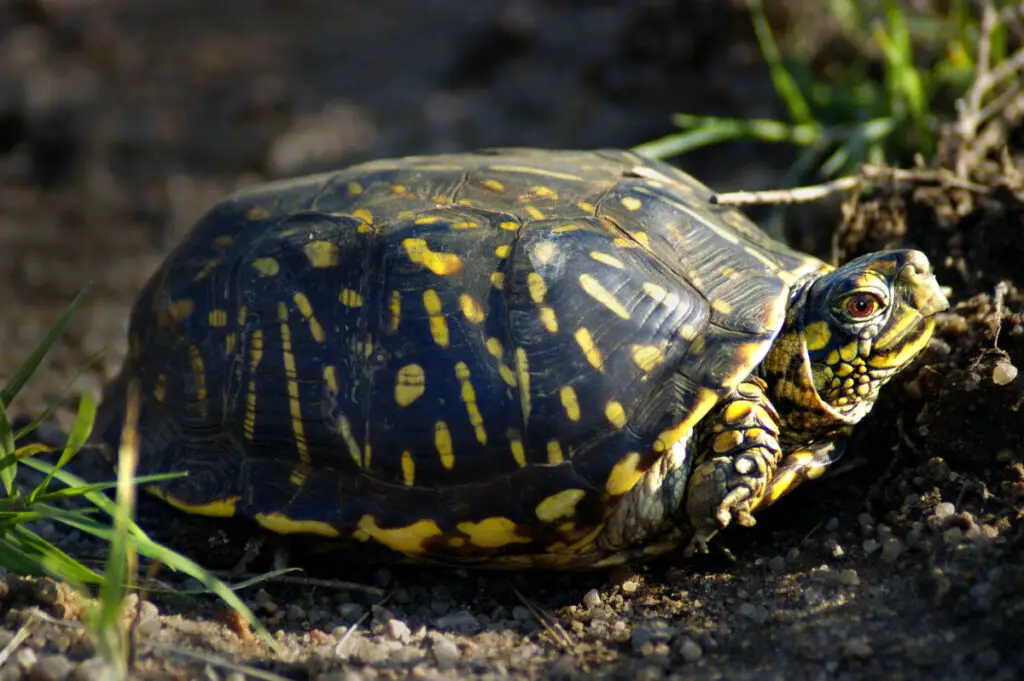
Biologically referred to as Terrapene ornata ornata, this is one of the two terrestrial turtles native to Oklahoma. The other is the one we discussed above; the three-toed box turtle.
A major distinguishing feature between the ornate and the three-toed box turtles is that the ornate one lacks markings on its plastron.
Ornate box turtles’ unique features are its high domed shell with yellow lines on the scutes on plastron and carapace, a plastron hinged at the anterior and posterior, and non-webbed hind feet.
Mature males have red eyes while females have yellow or brown eyes. The upper is also concave-shaped in males and flat=shaped in females. Males also have more elongated, fat tails and a long claw on their hind feet used when mating.
The turtle is a land-dwelling species and is expected in the open western parts of Oklahoma. Their diet is omnivorous, and they mainly feed on plants, flowers, fruits, worms, slags, various insects, and carrions.
It is one of the turtles that stay small, only reaching a length of 5 inches when mature, while baby turtles measure about one inch. They live for 30 to 40 years and weigh between 0.5 and 1.5 pounds. Ornate box turtles achieve sexual maturity at between 8 and 10 years.
Mating occurs between May and October. Their eggs hatch between the end of July and August, depending on moisture levels and temperature. The gender of the baby turtles relies on temperature, with lower temperatures producing more males.
Ornate box turtles are of great conservation concern in Oklahoma. Their main threats in the wild are illegal collection and being hit by vehicles on highways. To curb this, Oklahoma turtle laws have been implemented prohibiting the commercial collection of all box turtle species.
10. Eastern River Cooter
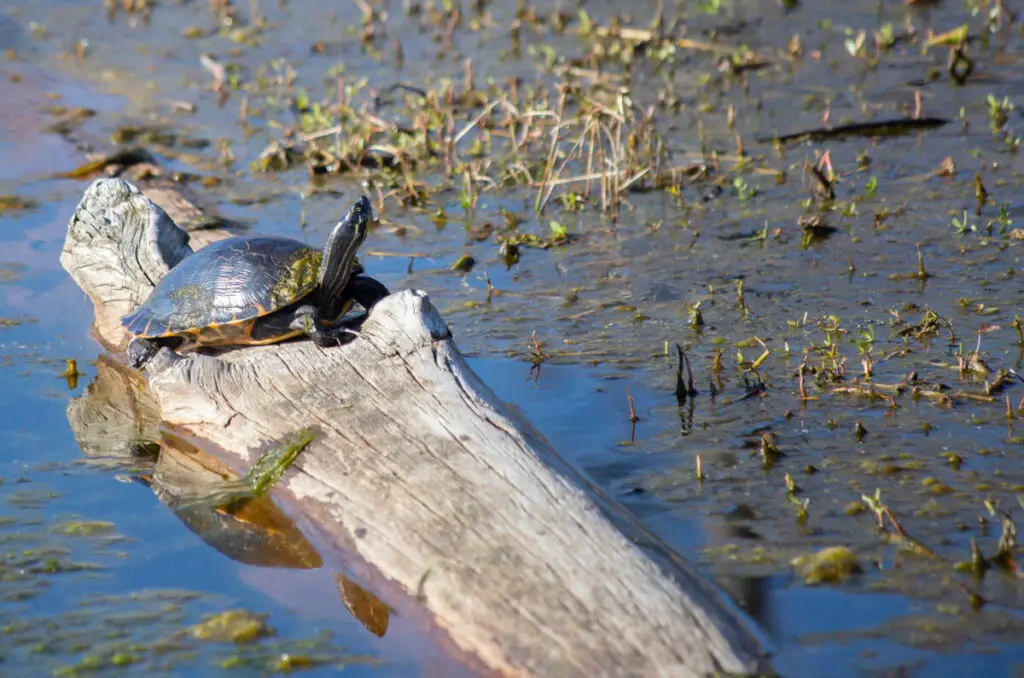
Also known as gulf cooters, these turtles go by the scientific name Pseudemys concinna concinna. Their upper shell and skin are dark green and also have a mixed pattern of orange to yellow curved lines forming full circles and half-circles in other scutes. The plastron is not hinged and is yellow, featuring dark markings that go away as the baby turtles age.
It is one of the turtles that grown medium-large attaining a length of 16 inches when mature. Hatchlings measure less than an inch. The average lifespan of the Eastern river cooter is 40 – 50 years.
They are aquatic and often inhabit ponds, large streams, lakes, and rivers, especially in the eastern parts of Oklahoma but at times extend to the central parts. They hardly leave water unless to lay eggs or look for other aquatic habitats.
In terms of feeding, they are largely herbivorous but eat more meat when younger to meet the protein requirements for growth. Their diet comprises aquatic vegetation, fish, and insects.
Mating occurs in spring and is initiated by the males who flit their claws in the female’s face while still in the water. If receptive, the female sinks to the bottom of the water body where mating occurs.
Female Eastern river cooters lay 15-30 eggs near the water body but not within reach of risen water levels. They lay up to 3 clutches in a year, and the number of eggs varies depending on the size of the female, with the bigger ones laying up to 30 eggs. These eggs take 45- 55 days to hatch.
In terms of conservation, Eastern river cooters in Oklahoma are of the least concern.
11. Western Chicken Turtles
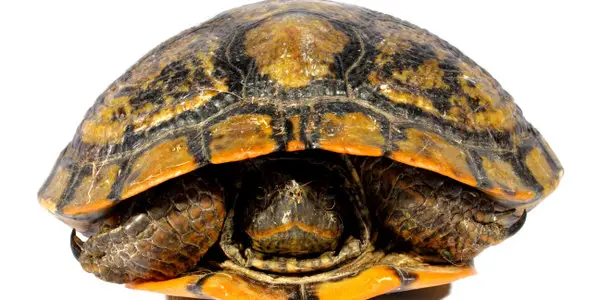
Western chicken turtles get their name because they have been hunted for meat in the past. Scientifically, they are known as Deirochelys reticularia miaria. They have long striped necks, and their shells are more flattened than in other species.
These turtles are semi-aquatic and often inhabit slow-moving, still waters such as swamps and ponds in the southeastern parts of Oklahoma. Thick vegetation is a vital component of their habitats.
A Western chicken turtles’ shell is oval in shape, rough, and has an olive, dark brown to black color. The shells also bear swirling yellow marks that resemble a fishing net. They bear the scientific term reticular, meaning net-like refers to these marks or patterns on the shell.
These turtles have an omnivorous diet, primarily feeding on fish, insects, mollusks, and plants. When mature, they measure between 4 and 10 inches. Their lifespan ranges between 15 and 30 years, depending on environmental factors.
It is a hibernating species, and during summer, they bury themselves in thick shrubs or thorny vines for aestivation.
If you want to get the Western chicken turtle as a pet, you need to have experience handling turtles. They cost between $130 and $200.
12. Common Snapping Turtle
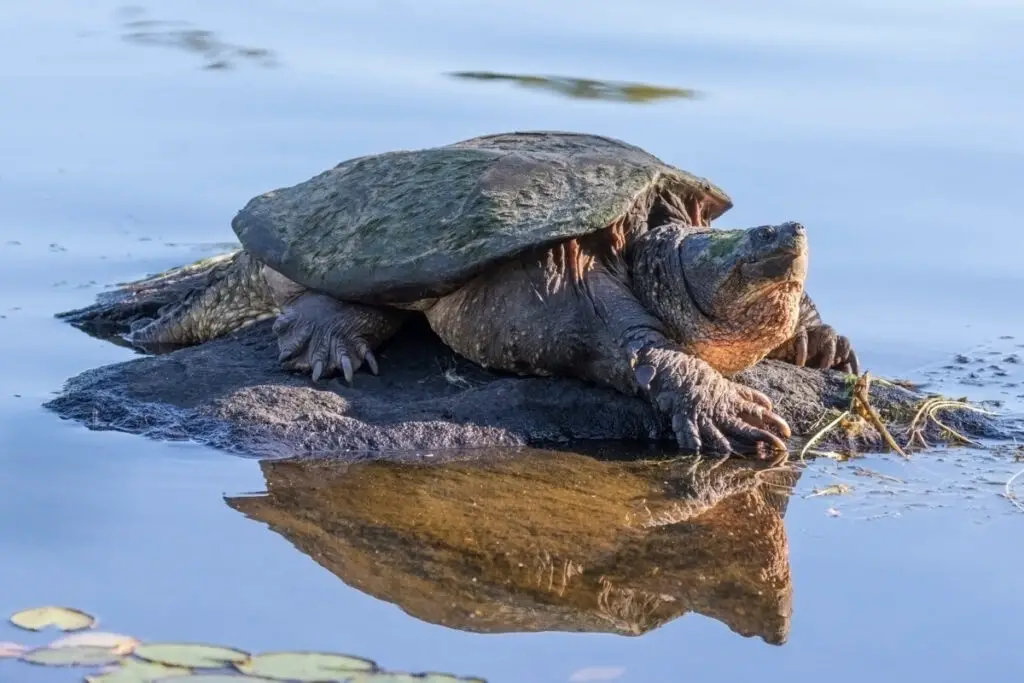
Although the above alligator snapping and this one have almost the same name, it is easy to tell them apart. While the alligator snapping’s shell has ridges, the common snapping species shell is smooth. Alligator snapping turtles are also bigger.
They have a smooth dark carapace. As hatchlings, they measure one-inch-long and grow to between 8 and 14 inches when mature.
Like the alligator snapping in Oklahoma, common snapping species spend most of their time in water and hardly basks. They commonly inhabit creeks, marshes, ponds, lakes, and rivers. During winter, they bury themselves in dead vegetation and mud till spring approaches.
Common snapping turtles are omnivorous and feed on aquatic vegetation, small vertebrates, and aquatic invertebrates.
Breeding takes place during spring and fall. Sexual maturity is achieved in 5-7 years after hatching. The females lay between 25 and 50 eggs, almost half of which are eaten by skunks. The sex of the hatchlings is moisture-dependent. Their hatchlings are threatened by predators such as crows, snakes, big fish, bullfrogs, and herons.
Common snapping turtles have a lifespan of around 30 years but can live for longer when well taken care of them in captivity.
13. Red-eared Slider Turtle
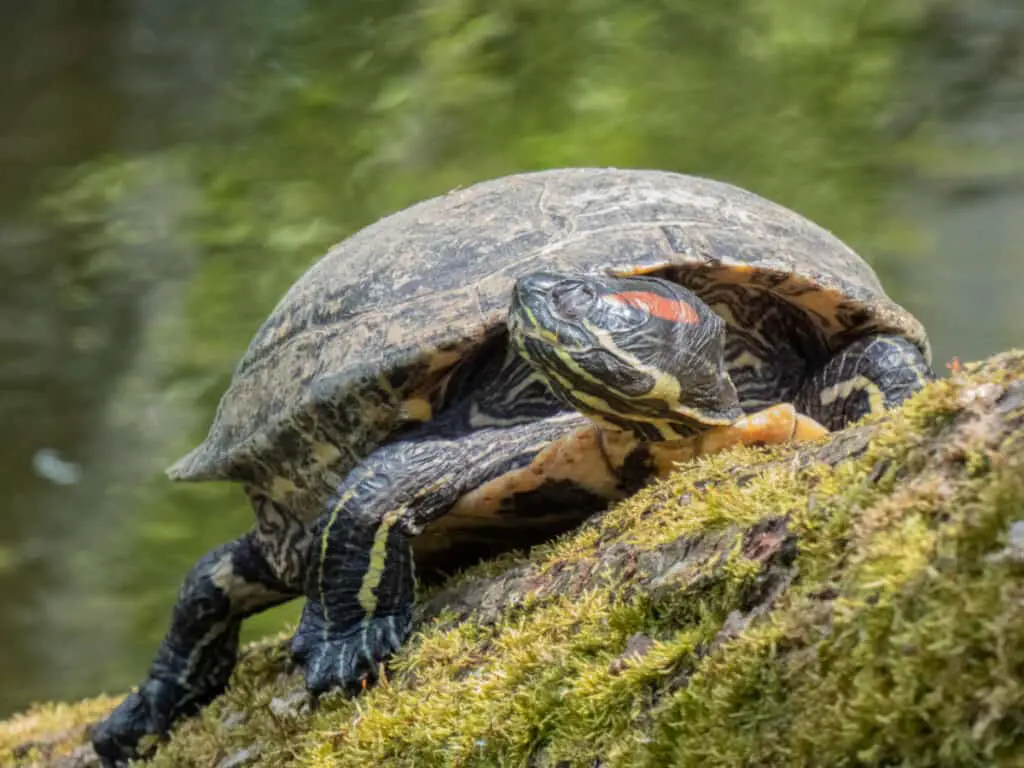
The red-eared slider goes by the scientific name Trachemys scripta elegans. It also bears other names like water slider and Red-eared terrapin.
Red-eared slider species are a highly bought turtle species being kept as pets. This species is friendly and more sociable than most of the other turtle species. The turtle hardly grows big, only getting to 6-8 inches, and they are pretty affordable, only costing $15 to $50.
As the term suggests, it has a red patch behind each eye. Their shell is olive greenish, and the scales have yellow marks.
They are present across Oklahoma other than in a few western counties. It is semi-aquatic and inhabits slow-moving warm water bodies like lakes and rivers.
The red-eared slider feeds on an omnivore’s diet. Their main food includes aquatic vegetation, small fish, and insects. Baby red eared sliders feed on more proteins and transition to more plants as they grow.
You can slice carrots, green beans, and squash into tiny pieces and feed the turtle in captivity. Mineral and vitamin supplements, especially Calcium, are also vital in boosting the turtle’s growth.
These turtles carry Salmonella, and they can pass it into humans, especially children. Due to this, the US at large banned the sale of red-eared sliders measuring below 4 inches.
This turtle species reaches reproduction maturity at the age of 5 to 7 years. Nesting takes place between the end of April and early August. The number of eggs laid by the species depends on the size of the female, with bigger females laying more eggs up to 17 eggs. Depending on rainfall and temperature, red-eared hatchlings emerge between July and September.
In terms of conservation, their population is declining because of road mortality and harvest for commercial purposes. Even so, they are turtles of least concern because the increase of artificial water bodies such as ponds is helping with the increase of their population.
14. Common Musk Turtle
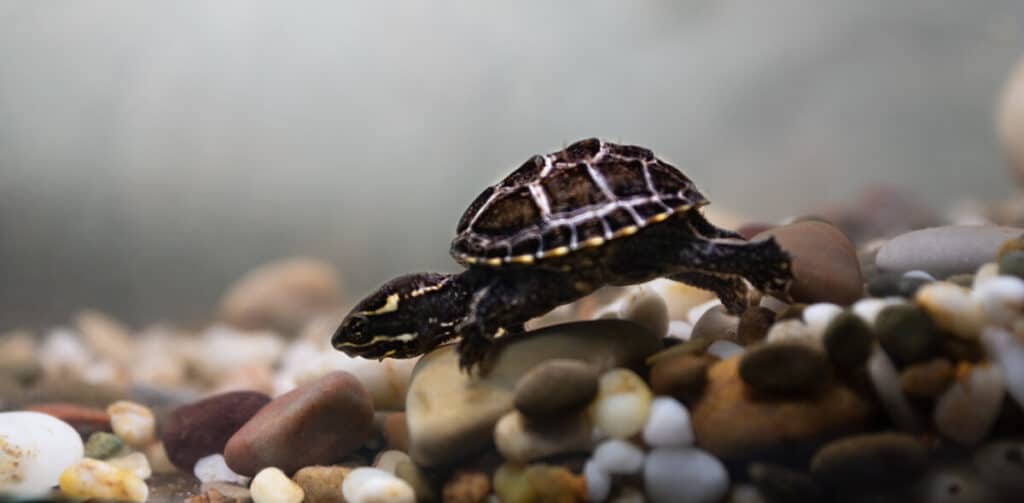
This turtle, with the biological name Sternotherus odoratus, bears a plain color appearance. It is also known as Stinkpot or the Eastern musk turtle. They remove a strong smell when approached by a predator that works as a defense mechanism.
The shell and skin are similar in appearance, with either a black or dark brown color. Their heads have a pair of yellow stripes running from the nostrils to the necks. On their throats and chins, they have fleshy barbels. A unique feature of this turtle species is that its shell has a ridge that runs from the front to the back.
In terms of habitat, common musk turtles are often found in marshes, bogs, and other slow-moving waters. They are common in the Southeastern and Northeastern parts of Oklahoma.
These turtles are omnivores, mainly feeding on tiny aquatic animals as well as semi-aquatic animals such as mollusks and crustaceans. They also feed nocturnally on aquatic plants, fruits, and vegetables.
Common musk turtles rarely grow big as their size ranges between 3 and 4.5 inches when fully grown. Their expected lifespan ranges between 30 and 50 years in the wild, and they can live for longer if well taken care of as pets.
If you want to keep a common musk pet turtle, you would need some experience in turtle care. On average, a pet musk turtle costs between $20 and $90.
15. Painted Turtles
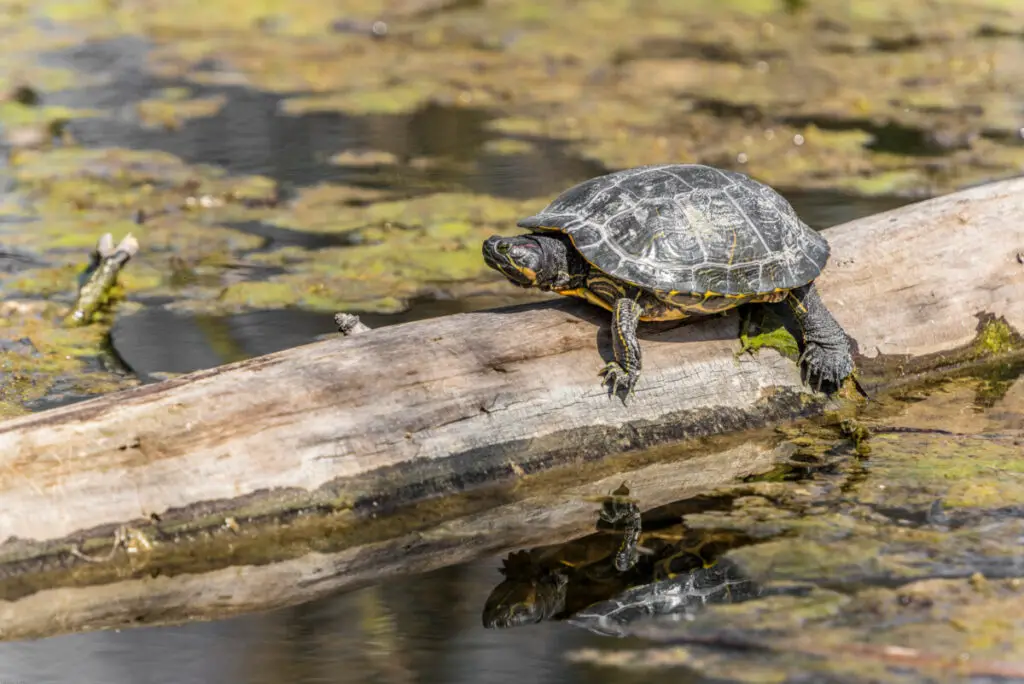
There are two Oklahoma native subspecies of painted turtles; the Western painted turtles are scientifically known as Chrysemys picta bellii, and the Southern painted turtles, scientifically known as Chrysemys picta dorsalis.
The upper part of their shells is dark brown to black and features yellow, green, and red marks, which is where they get their name. Their heads have yellow stripes, and the edges of the shells are yellow to red. They measure between 4 and 10 inches when mature making them moderately sized turtles.
A distinguishing feature of the two is that the southern painted subspecies has a yellow or tan lower part of the shell and an orange or red line traversing the upper part of the shell, while western painted subspecies do not have this stripe and the lower part of their shells has a marble pattern of green, red and other colors.
Painted turtles are aquatic and can be found in most counties in Oklahoma. These turtles often inhabit marshes, ponds, and other shallow waters with sandy bottoms. They have a preference for areas with a lot of aquatic plants.
These turtle subspecies are omnivores. During winter, they go into hibernation and have the ability to remain dormant for up to 4 months.
16. Spiny Softshell
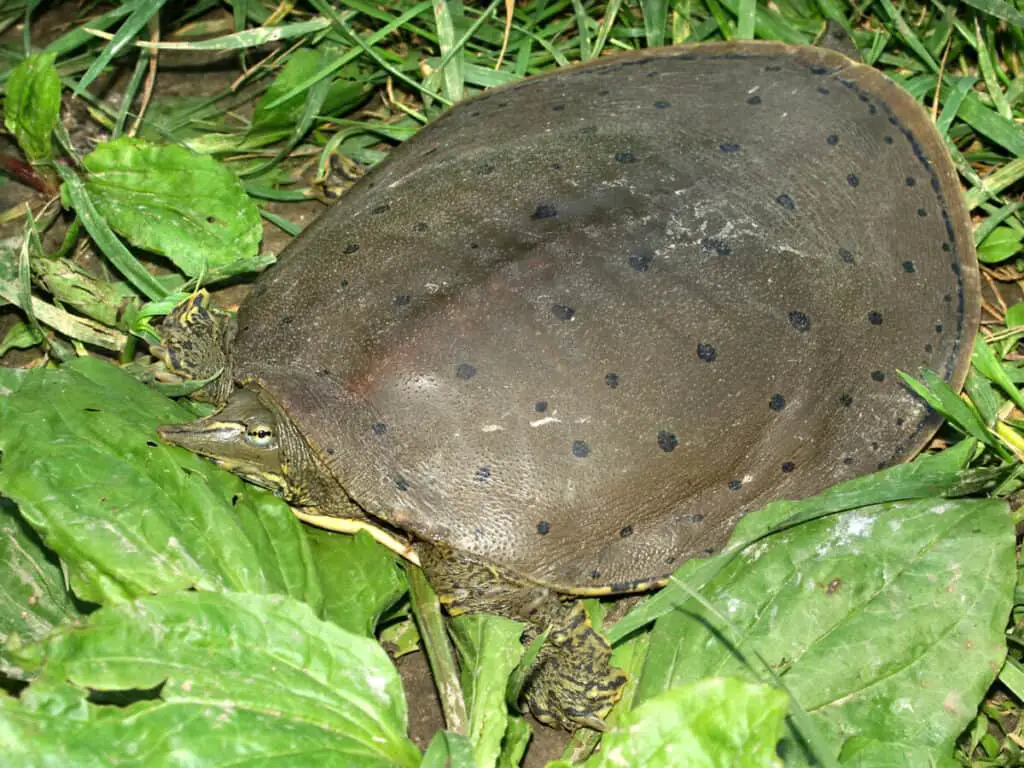
There are two subspecies of the spiny softshell turtles found in Oklahoma. These are the Eastern spiny softshell and the pallid spiny softshell, whose biological names are Apalone spinifera spinifera and Apalone spinifera palilida, respectively.
As their name suggests, they have a smooth shell with no scutes. The shells have a leather-like look and unique spikes at the back and front, distinguishing them from the smooth softshell we will discuss next. Spiny softshell’ shells are also hinged at both ends. The opening of their nostrils has tinny ridges that project towards the center.
Common in the eastern part of Oklahoma, these spiny softshell turtle species are aquatic, and they inhabit lakes, rivers, and streams. It is common to see these turtles basking on sandbanks and logs. They make great swimmers.
Spiny softshell turtles have an omnivorous diet but tend to eat more meat, with their main prey being snails, crayfish, and insects.
Female spiny softshell turtles can grow up to 17 inches, while the males grow to about 9 inches in upper shell length. Because they have strong jaws and beaks, you would need to handle them with care.
Nesting occurs between late May and July. They lay between 3 and 40 eggs per clutch and can lay up to 2 clutches in a year. Their hatchlings start emerging in August, and they measure about 1.5 inches long.
Spiny softshell is a turtle species of special concern in Oklahoma.
17. Midland Smooth Softshell
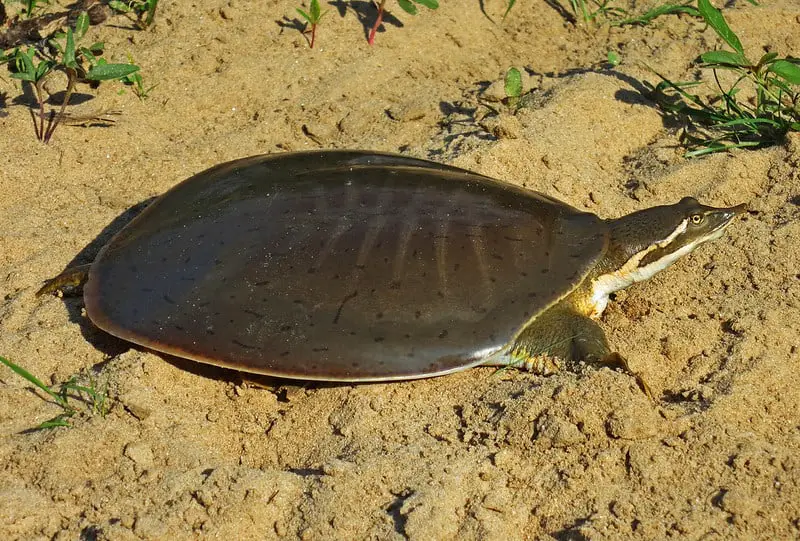
Apalone mutica mutica is the scientific name of this turtle, and it is also known as spineless softshell. Their shells are smooth, leather-like, and resemble a pancake. Due to the softness of the shell, this turtle subspecies is unable to use it as a defense mechanism like other turtles do.
They have a grey or brown appearance with cream lines running from the back of the eyes. Their long and tapered snouts can also identify them. Midland smooth softshell are aquatic, and they inhabit major river systems in Oklahoma. Sandbars are vital in their habitats for nesting purposes.
The diet of Midland smooth softshell turtles consists of insects, crayfish, frogs, worms, and insects. Because they lack a hard shell and instead have a layer of cartilage around the shell, they are great, fast swimmers. Their swimming is so good that they are able to prey and catch live fish easily.
Midland smooth softshell turtles have a lifespan of about 25 years. When mature, females measure between 4.5 inches and 14 inches, but males only reach 7 inches. A juvenile Midland softshell will cost you an average of $50.
Males achieve sexual maturity at about four years of age, with the females taking five more years. Females dig shallow nests on sandbars where they lay eggs between May and July. Hatching occurs in August.
Midland smooth softshell are species of great concern in Oklahoma.
Conclusion
We have had an in-depth look at the 17 turtle species native to Oklahoma and how they vary in terms of habitat, diet, nesting, etc. For the purposes of conservation, there are Oklahoma turtle laws that govern the sale, purchase, and keeping of these turtle species.
The sale of the two terrestrial turtles in Oklahoma, i.e., Three-toed box and ornate box turtle, is illegal, but the law allows you to pet one from the wild. It is also illegal in Oklahoma to own an alligator snapping, common map, or the western chicken turtle. Oklahoma turtle laws also prohibit you from keeping more than six species of the other turtles.
We trust that this detailed turtles in Oklahoma guide has helped you learn a lot more about Oklahoma native turtle species.
Learn more about other turtles species:
- Kentucky Native Turtles (17 Species With Pictures)
- Turtles In Alabama (30 Species with Pictures)
- Indiana Native Turtles (Ultimate Guide With Pictures)
- Michigan Native Turtles (10 Species with Pictures)
- 18 Native Turtles in Tennessee (Guide With Pictures)
- Common Turtles Species in Massachusetts
- Turtles In South Carolina (20 Species With Pictures)
- Florida Turtles Guide (Full Guide With Pictures)